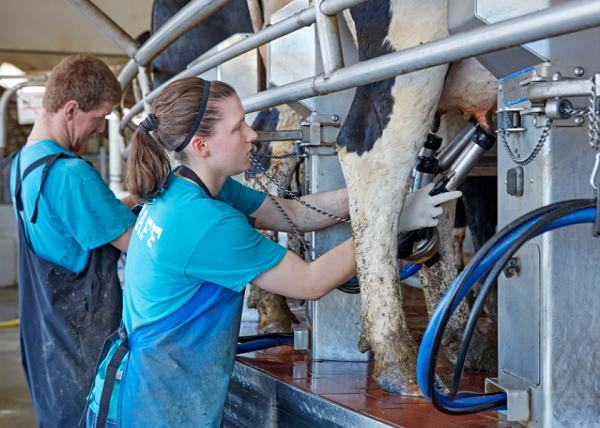
The little things we do during milking time have a profound effect on udder health and milk quality. It is important to remember that every quarter of every cow must be prepped for milking the same way by every milker at every milking. Specifics of milking procedures may vary from farm to farm. For example, one farm may prep cows in sets of 4 cows, while the next farm preps in sets of 6. However, the basics of timing should ideally be the same or similar on every farm.
The first important time frame to remember relates to contact time of the teat dip being used as pre-dip. The contact time of teat dips applied before milking need to be on the teat skin for a minimum of 30 seconds to have adequate killing effect. During this time, the quarters can be stripped, but the dip needs to remain on the teat skin for the full 30 seconds prior to wiping. In addition to contact time, we must ensure that the “prep lag time” has an average length of 90 seconds from start of tactile stimulation. Prep Lag-Time by definition is the time from the start of either stripping, massaging or wiping the teats with a towel, whichever comes first to unit attachment. On some farms this is stripping and others it is wiping, depending on the order of your preparation procedures. If we attach the units prior to the 60-second mark, we have not given adequate time for oxytocin to reach a useful concentration in the udder. On the flip side, we need to ensure units are attached within 90 seconds of stimulation to make maximum use of the letdown effect. Consider taking a stopwatch to the parlor, check your timing of milking procedures and make necessary adjustments to your routine until you are within these time frames.
One suggested protocol would include prepping cows in blocks of 4 or 5. Begin with the first cow by removing lose debris with a towel, then stripping each quarter and examine the milk for signs of mastitis. This would be repeated for the remaining cows in that block. Start back at the first cow of the block (do not weave back through the cows in reverse order) and apply the pre-dip ensuring at least half of the teat is covered. Once the entire block has been pre-dipped, begin wiping the first cow of the block with a single-use towel. At this point, you should be able to also attach the unit before wiping the second cow of the block. However, check your timing and make sure a full 60 seconds have elapsed from the time that cow was stripped. If you are shy of the 60-second mark, continue wiping the remaining cows in the block and then return to attach the units, starting at the first cow. Once you have a routine established, you will need to monitor the routine monthly.
Provided by Dairy Pipeline
Related Articles & Free Email Newsletter Sign Up
Do Silage Inoculants Survive the Ensiling Process?
How To Splint a Calf’s Broken Leg




Comment here